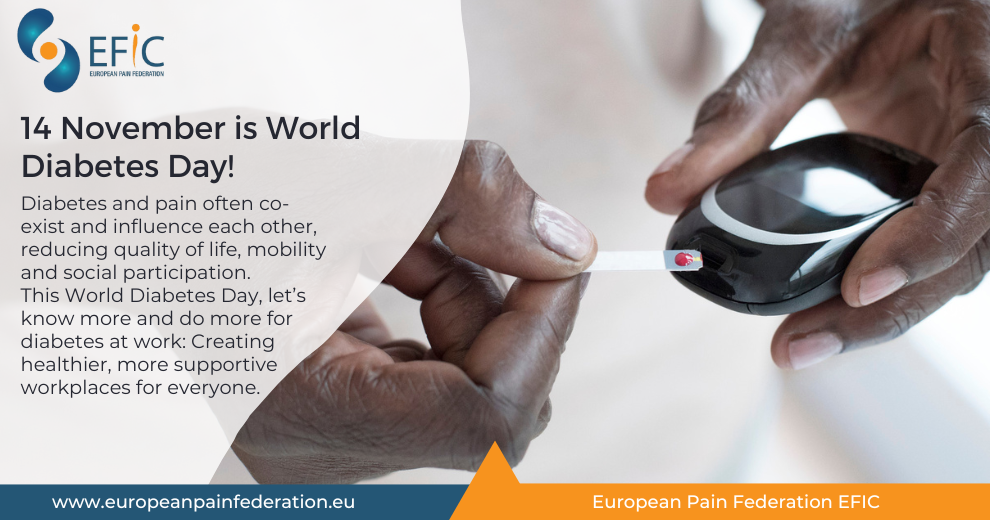About World Diabetes Day
Know more and do more for diabetes at work
In 1991, World Diabetes Day was established by the International Diabetes Federation and the World Health Organisation in response to growing concerns about the escalating health threat posed by diabetes. Today, 8.5% of the global adult population lives with diabetes, making it one of the most significant public health challenges worldwide.
This year’s theme, “Know more and do more for diabetes at work”, highlights the importance of understanding and supporting people with diabetes in the workplace. Millions of employees face daily challenges managing their condition, including stigma, discrimination and exclusion, all of which can have a serious impact on their wellbeing and mental health.
- 7 in 10 people living with diabetes are of working age
- 3 in 4 experience anxiety, depression or another mental health condition because of their diabetes
- 4 in 5 experience diabetes burnout
Creating healthier and more inclusive workplaces requires awareness, empathy and practical action. Employers and colleagues can make a meaningful difference by fostering open communication, offering flexible support, and promoting wellbeing initiatives that empower people with diabetes to thrive at work.
Pain and diabetes
Pain and diabetes commonly co-exist. Elevated blood sugar levels can gradually cause tissue damage in the nervous system, leading to painful neuropathies. The most common form, distal symmetrical polyneuropathy (DSPN), affects up to 50% of people with diabetes. Symptoms often begin at the toes and progress through the feet and lower legs.
Other forms of diabetic neuropathy may also occur, such as cardiovascular autonomic neuropathy or atypical presentations like carpal tunnel syndrome. In addition, diabetes increases the risk of tendon pain, and frequently co-exists with spinal, hip and knee pain.
Assessing and managing diabetic neuropathy
The EFIC Academy Education Platform offers comprehensive educational resources on the assessment and management of neuropathic pain, including diabetic neuropathies. Learners can explore self-directed modules or follow tailored learning tracks designed to meet individual needs. Access is available to EFIC Academy members.
Together, let’s know more and do more for diabetes at work, creating environments where everyone can live and work well with diabetes.
To download World Diabetes Day’s comprehensive resources including social media tookits, please visit: https://worlddiabetesday.org/resource-hub/
Related initiative: EFIC On the Move
EFIC’s On the Move campaign promotes physical activity as a key factor in preventing both chronic pain and long-term conditions such as diabetes. By encouraging movement and supporting healthy lifestyles, EFIC continues to advocate for prevention, wellbeing and better quality of life across Europe.
Scientific content
Review article – Botulinum A toxin for chronic peripheral neuropathic pain
Hary V, Schitter S, Martinez V. Efficacy and safety of botulinum A toxin for the treatment of chronic peripheral neuropathic pain: a systematic review of randomized controlled trials and meta‐analysis. Eur J Pain. 2022;26(5):980–990.
Original article – Metformin and musculoskeletal pain
Carvalho-e-Silva AP, Harmer AR, Ferreira ML, Ferreira PH. The effect of the anti-diabetic drug metformin on musculoskeletal pain: A cross-sectional study with 21,889 individuals from the UK Biobank. Eur J Pain. 2021;25(6):1264–1273.
Original article – Sensory profiles in diabetes with/without neuropathy
Raputova J, Rajdova A, Vollert J, et al. Continuum of sensory profiles in diabetes mellitus patients with and without neuropathy and pain. Eur J Pain. 2022;26(10):2198–2212.
Short communication – Capsaicin 8% patch vs pregabalin
Cruccu G, Nurmikko TJ, Ernault E, et al. Superiority of capsaicin 8% patch versus oral pregabalin on dynamic mechanical allodynia in patients with peripheral neuropathic pain. Eur J Pain. 2018;22(4):700–706.
